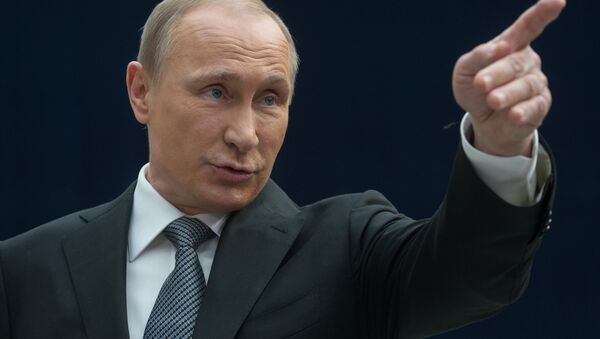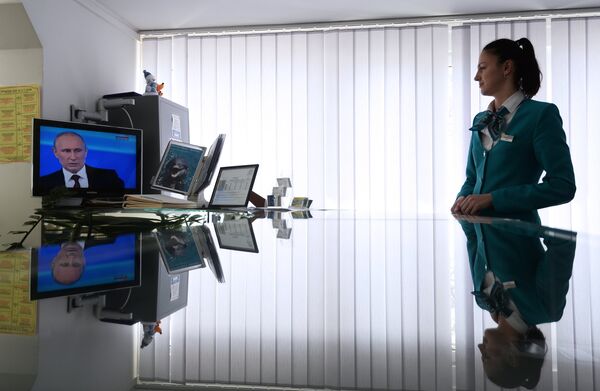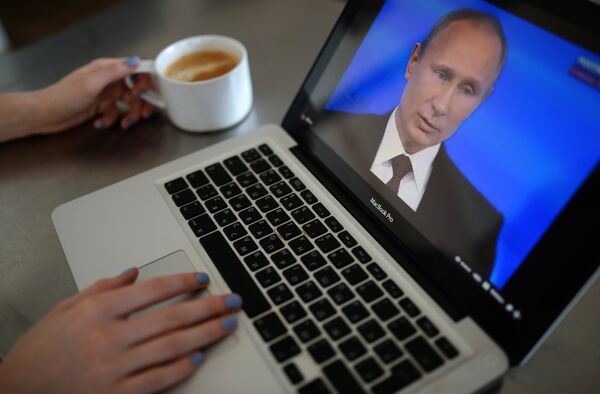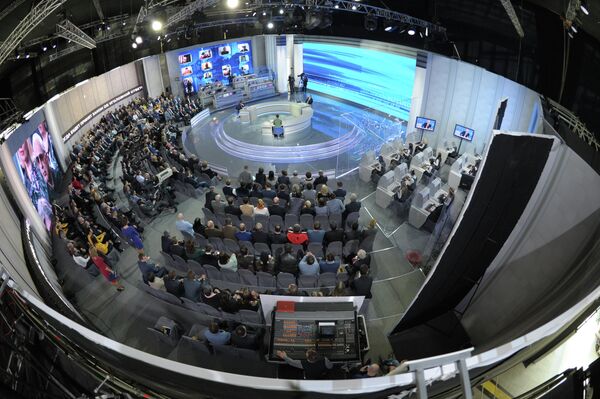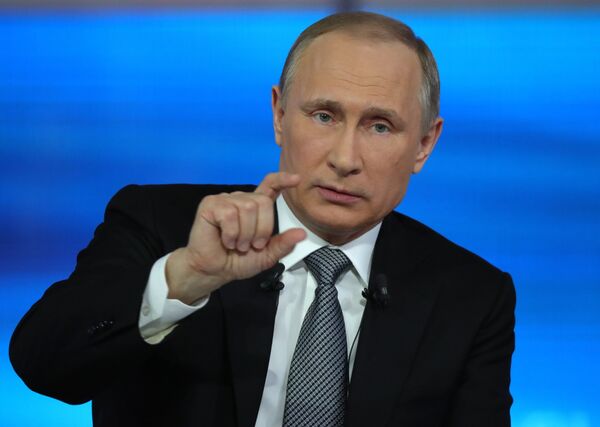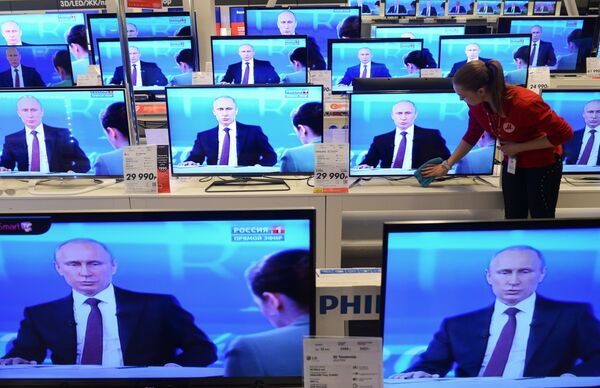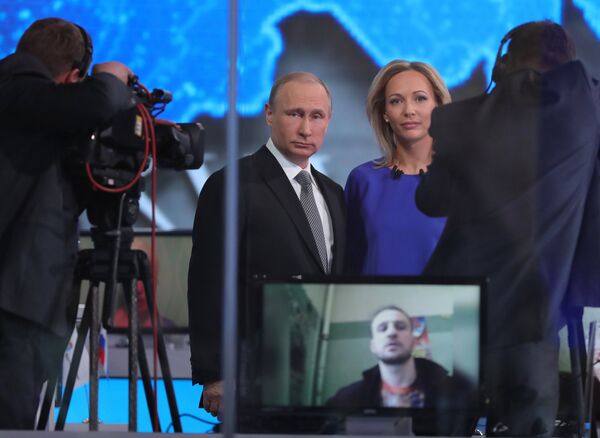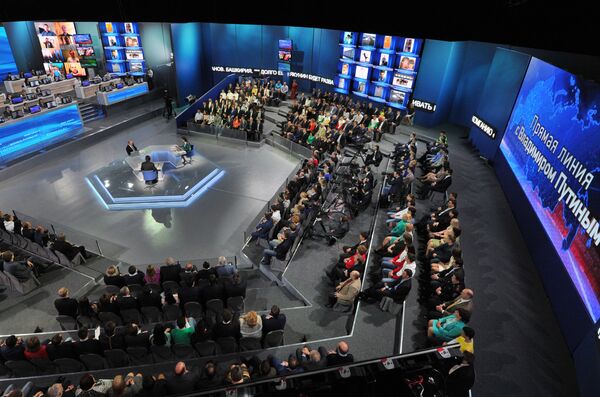The Direct Line with President Putin, which has become a traditional call-in session through the course of his presidency, started during his first presidential term, on December 24, 2001.
December 24, 2001
The Russian leader received 400,000 questions but was able to address only 46 of them. His communication with the country lasted two and a half hours, one hour longer than initially planned.
During his first Q&A Session, the President promised his people that he would answer their questions during live broadcasts.
December 19, 2002
The second session took place the following year. It lasted five minutes longer that the previous one (2 hours and 35 minutes), and the President was able to address more questions (51). The event, however, generated far more interest among Russians: the call center received 1,422,000 calls.
Unlike the first session held in 2001, when the studio was mainly connected to large cities, in 2002 the studio spoke to six regional centers, two villages, and two towns.
The bulk of the questions concerned social issues such as wages, pensions and high utility rates. About 20 percent of the questions were about living standards, half of which were about housing. As in 2001, the majority of questions came from senior citizens.
December 18, 2003
During his third call-in session, the President answered 68 questions from all over the country: Moscow, Komsomolsk-on-Amur, the coal quarry Chernigovsky in Kemerovo Region, Krasnoyarsk, Kant Air Force Base in Kyrgyzstan, Drilling Rig No. 504 in the Vostochno-Surgutskoye oilfield, Nalchik, Vologda, the village of Novaya Derevnya in Stavropol Territory, Nizhny Novgorod, Michurinsk and Vyborg.
The session lasted 2 hours and 50 minutes. The percentage of questions answered was divided evenly between those sent via the Internet, which the President chose himself, those asked over the telephone, and those asked during the live broadcast. In all, there were 1,553,000 calls.
During this session, Putin announced his intention to run for reelection.
2004
This year the Russian leader decided to take a break from the national call-in session format. Instead, the Russian President held a large-scale news conference in the Kremlin.
September 27, 2005
The fourth line was opened on September 27, 2005; questions could be asked not only via a specially created website and by telephone, but also, for the first time, via mobile phone text messages.
As in previous years, most people were worried about economic and social matters. Within 2 hours and 53 minutes, the President was able to answer 60 questions, 14 of which he chose himself.
The overwhelming majority of the questions had to do with domestic policy, with only six questions concerning international problems. Just one inquiry was of a personal nature.
More than one million questions were registered, including one million by telephone and over 100,000 via text message. The most active categories were blue-collar workers, office workers, retirees, students, and housewives, who were mainly concerned about salaries, pensions, housing, healthcare services, and support for those serving in the military.
October 25, 2006
The fifth Direct Line of the President with his nation lasted 2 hours and 54 minutes, where he answered more than 50 questions asked via video linkups with populated centers in various parts of the country, by telephone, and on the Direct Line website. Of these, 41 concerned domestic matters, nine dealt with international affairs, and two were of a personal nature.
The overall number of questions exceeded 2.3 million, including 2.2 million lodged by telephone and 100,000 via the Internet. A special text message line was also available throughout the broadcast.
Direct linkups were organized with Baltiysk, Bryansk, Irkutsk, Kaspiysk, Kondopoga, Naberezhnye Chelny, Nakhodka, the village of Podgorodnyaya Pokrovka in the Orenburg Region, and Tver. Additionally, a number of questions were also asked live from Crimean Sevastopol.
October 18, 2007
The sixth Direct Line, on October 18, 2007 became the largest at that time in terms of both duration and the number of questions asked.
During the 3 hours, 5 minutes and 40 second session, Putin answered 72 of the more than 2.5 million questions. As before, people mostly expressed social concerns related to improving salaries and pensions, social benefits for pregnant women and young mothers, housing, and rising food prices.
Eight questions each were asked about the economy, international issues and domestic policy. The President also answered four personal questions, three questions about the Olympic Games, three about the army, and two about association football (soccer).
The studio was connected to 67 cities throughout Russia and the CIS (Commonwealth of Independent States) countries, with people from 12 of them getting to ask questions live on air. The President then received 2,276,931 calls.
December 4, 2008
On December 4, 2008, during his seventh Direct Line, Vladimir Putin for the first time answered questions as the country's Prime Minister and the head of the United Russia party.
A special program, the "Talk with Vladimir Putin," lasted for 3 hours and 8 minutes, 3 minutes longer than the previous year's call-in program.
Putin answered 80 questions asked by phone, text messages, and online, as well as via mobile television stations installed in Russian regions. There were 1,636,800 calls and 642,000 text messages.
The bulk of the questions concerned the consequences of the global financial crisis, rising gasoline prices, pensions, social benefits and wages in the public sector, as well as maternity capital and mortgages for young families.
December 3, 2009
On December 3, 2009, then-Prime Minister Vladimir Putin held his eighth Q&A session, called "A Conversation with Vladimir Putin: Continued."
The program lasted 4 hours and 2 minutes. The Prime Minister answered over 80 of the more than two million questions that came in via phone, text message, and emails sent to www.moskva-putinu.ru.
The 2009 Q&A session focused on support for industries. Putin spoke with employees of the companies he had previously visited, telling them about practical support measures and promising to visit again in the event of any problems. Putin also spoke about macroeonomics, mentioning gloomy figures of the 2009 GDP and industrial production decline, but expressed hope that things might start getting better in 2010.
December 16, 2010
The 2010 Q&A session had the same name as it had the previous year: "A Conversation with Vladimir Putin: Continued."
It was the ninth live session and beat the previous record by 24 minutes; it lasted 4 hours and 26 minutes. Of the more than 2 million questions received, Putin answered 90 questions, 31 of which he chose himself.
Most of the questions concerned socioeconomic issues and the consequences of the devastating wildfires that had hit Russia that summer. The Prime Minister was also asked about preparations for the 2014 Sochi Olympics and 2018 FIFA World Cup. One person asked whether Vladimir Putin had had to give an order to kill a traitor.
The Prime Minister received over 2,000,000 questions, of which half a million were texted, while 1,400,000 were phone calls and the rest came from the website.
December 15, 2011
On December 15, 2011, Vladimir Putin spent four and a half hours answering questions. About 40 percent of the television audience that day tuned into the broadcast. Putin's tenth Direct Line Q&A session began at noon and ended 4 hours and 32 minutes later. During this time, Putin answered 88 questions, 25 of which concerned parliamentary election results, the next presidential election, Russian political parties, Putin's political plans, personal issues, and many other issues.
According to the direct line hosts, most of the 1,882,000 calls and texts that the specially set-up call center had received by 3:30 p.m. Moscow time concerned social services. These were followed by questions about utilities and amenities, followed by labor relations and wages. Putin was also asked private questions such as ones about his dreams, his plans for the New Year, what he believed brought him happiness, and which of his character traits he disliked.
2012
In 2012, there was no Direct Line with Vladimir Putin, but the Kremlin said they had not abandoned the format and promised to hold it later on, during the warm season.
April 25, 2013
On April 25, 2013, the President hosted his eleventh call-in and write-in session, this time called "Direct Line with Vladimir Putin."
That day, Vladimir Putin again broke his own record with a session lasting 4 hours and 47 minutes. The President answered 85 questions, including 24 rapid-fire questions, eight of which he chose himself and the rest were put forward by the session's hosts.
During the 2013 session, the call center fielded a record number of calls; around three million calls had been received as of 4 p.m. local time.
Russians were typically concerned about social issues, with some complaining about inflated utility payments and low wages live on air.
April 17, 2014
On April 17, 2014, the Russian President spoke with his country for the twelfth time. It was the second time during his current term in office, and the first to involve residents of Russia's newest region – Crimea.
The 2014 "Direct Line" lasted 3 hours and 55 minutes. Putin answered 81 questions, 35 of which concerned Crimea and Ukraine. The studio was connected with four Russian regions as well as to a studio in Berlin, which brought together international experts from the Valdai Discussion Club. Four of the questions asked during the broadcast came from Sevastopol. Putin also answered a video question from former US intelligence employee Edward Snowden.
April 16, 2015
On April 16, 2015, during his 13th direct line, the President received a total of 2,486,000 questions, of which 1,700,000 were by phone, and over 400,000 were texted.
The direct line went for 3 hours 57 minutes. Videolinks with six Russian regions were included. Vladimir Putin had time to answer 74 questions, which concerned sanctions and reciprocal sanctions, the situation in Ukraine, the investigation into opposition politician Boris Nemtsov’s murder, and such domestic issues as loans, mortgages and state services.
April 14, 2016
On April 14, 2016, the President hosted another "Direct line with Vladimir Putin".
A total of 2,500,000 questions were put to the President. That year, the program lasted 3 hours 40 minutes, and the President answered 80 questions, which focused mainly on domestic political and economic issues. They concerned the current state of the economy, rising prices on food products and drugs, inflation, wage arrears, and layoffs at social institutions.
Russians were very much interested in international affairs, asking questions about nearly all key foreign policy issues and the more relevant issues on the international agenda. Putin talked about the situation in Syria, the crisis settlement in Donbass and the Nagorny Karabakh region, Russia-US relations and Ukraine. Videolinks included Crimea, Sakhalin, Voronezh Region, Tomsk and Tula.

